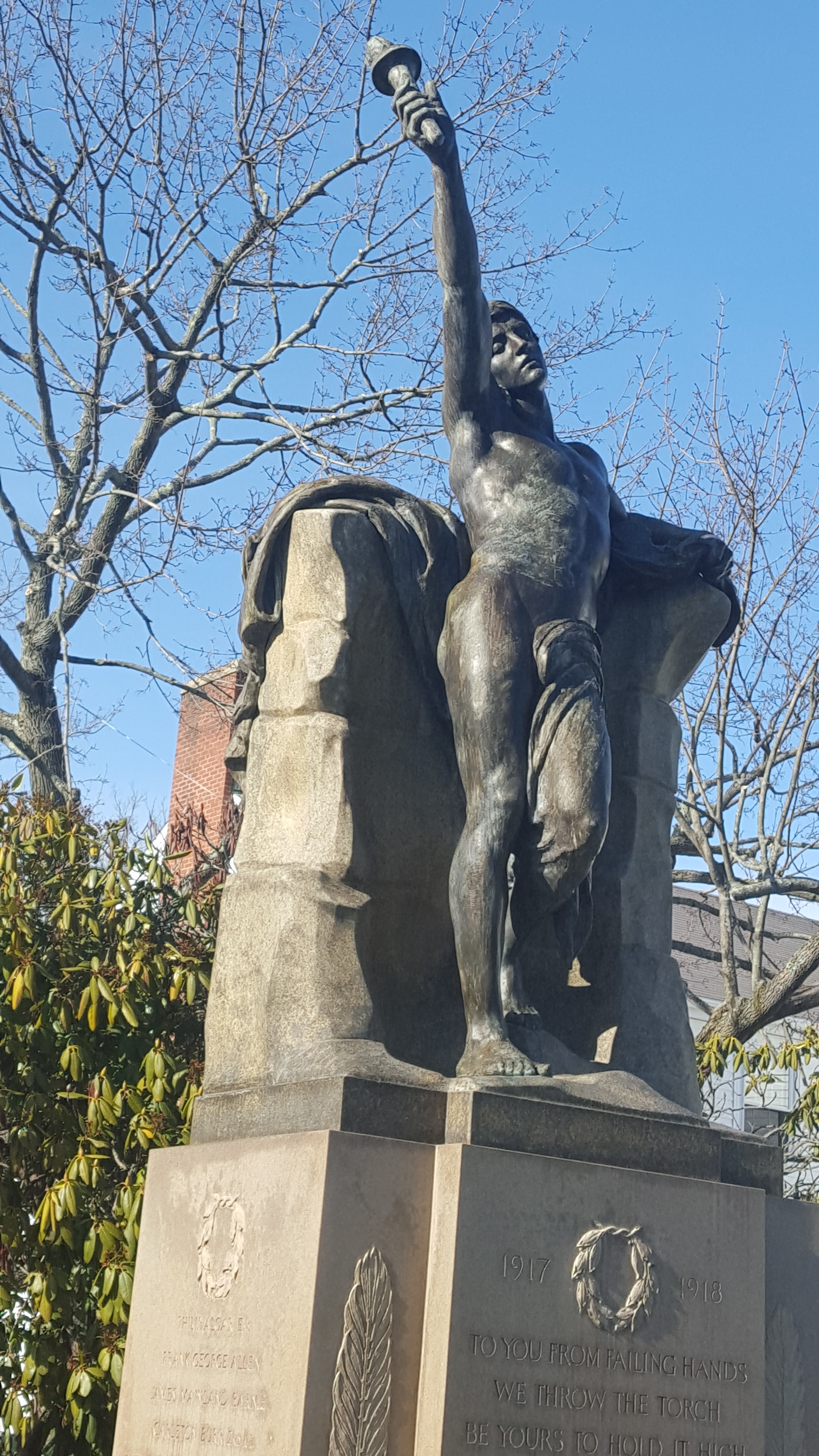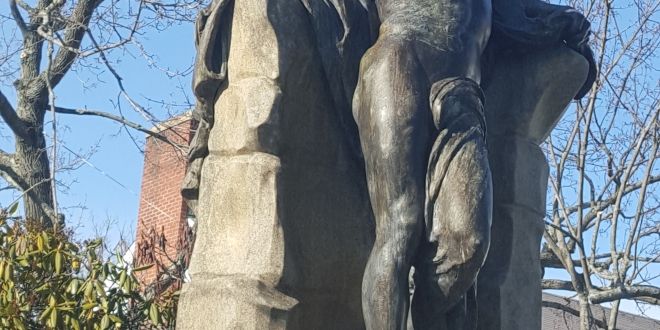Part 2: Role of freedom, spirituality and dharma
[Photo: A statue in Milton, MA, USA to commemorate those people from the town fought and died in World War 1 ]
To Dwight D. Eisenhower this power of freedom is natural: “Freedom has its life in the hearts, the actions, the spirit of men and so it must be daily earned and refreshed – else like a flower cut from its life-giving roots, it will wither and die.”
Current debate on the idea of nationalism in India has many limitations – the key one is the understating of these terminologies: Patriotism, Nationalism, Nation, State and Country etc. Different people understand these terms differently, interpret and express them differently.
Life is a series of changes for which we make a series of decisions (or in-decisions) and commit to actions (or inaction) based on our world view. Decisions are made using different human faculties. First with instincts, then emotion and also what we call logical, based on available facts. However facts are insufficient most of the time and instincts and emotions typically take over. There are rare occasions where some ‘other voice’ comes to us as ‘intuition’. Intuition has become an important subject of study today; however this has been part of the spiritual traditions all along – Intuition is a power of consciousness closest to the original source of all knowledge – jnana. Yoga is the methodology and path to realize the true knowledge. What is ‘spirituality’? The closest English world for Indian adhyatma is spirituality. It is defined as the science of self, to understand one’s inner core in relation to the rest of the creation, sometimes a ‘creator’ being absent. This is not about religion.
“…is the manifestation of divinity already in man. It is being and becoming, not hearing and acknowledging.” said Swami Vivekananda. In my personal view, spirituality is the ability to know the position of self and simultaneously connect with the world as part and larger extension of self. This is true Yoga and not much to do with ‘religion’. Adhyatma is experienced and expressed through dharma – sustaining principles and acts in all spheres between the self and the creation for mutual symbiotic relationships – family, society, country, land, air, plants, animals – all. So, it is not a religion, not a belief system, but the experience of ‘yoga’ or union in day to day life which an ‘atheist’, a ‘secular’ and a ‘religious’ person – can all agree to.
A lesser-known author and expert on non-verbal communication, especially in the animal world – J. Allen Boone most beautifully described this connectedness: “We are members of a vast cosmic orchestra in which each living instrument is essential to the complementary and harmonious playing of the whole.”
There is a social and legal force which is based on collective decision-making by society or the judiciary. It also plays an important role in our daily life – it is a mixture of utility, ethics and intuitive formulation of a harmonious social order.
I’ve mentioned ‘dharma’ several times by now but what it really is?
“Dharanat dharmam ityahu dharmo dharayate praajah Yah svadharansamyuktah sa Dharma iti nischayah.” The word Dharma is derived from dharana or sustenance; Dharma sustains society; that which has capacity to sustain, is indeed Dharma. -Mahabharat, Karnaparva, 69,59.
In the Shankaracharya’s introduction to ‘Commentary on the Gita’ he defined two-fold Dharma which has roots to rishi Kanada, founder of the Vaiseshika darshana, as such:
द्विविधःहिवेदोक्तःधर्मः, प्रवृत्ति–लक्ष्मनःनिवृत्ति–लक्ष्मनःच
तत्रएकःजगतःस्थिति–कारणंप्राणिनांसाक्षाद्अभ्युदय–निःश्रेयस–हेतुः
dvividho hi vedokto dharmah; pravíttilaksano nivritti-laksanah ca
tatra ekah jagatah sthiti karanam praninam sakshat-abhyudaya-nihshreyas-hetuh
‘The dharma taught in the Vedas is of two-fold nature, characterized by pravritti – outward action, and nivritti , inward contemplation (or power and tendency to detach), meant for the stability of the world, which are meant to ensure the true abhyudaya – freedom, material prosperity and socioeconomic welfare, and nihshreyasa – spiritual freedom and attainments of all beings.’ Modern society is on the edge of finding solution to the conflicts of material and moral wars. India responded to it long ago saying we need action along with meditative contemplation to have a sustainable – dharma-based world.
According to the Confucian idea of ’jen’, human-heartedness and righteousness is the basis of individual and social responsibilities where the proper conduct of relationships is most important. Self development and sustenance based one this inner morality in turn develops and sustains others. This is very similar to the idea of dharma.
According to Taoism, Tao, similar to the idea of dharma, is an emblem, meaning order, the whole, responsibility, efficiency. It is the Responsible Efficient, Total Order, creations as a whole, the whole of what is, multiplicity..
Management Guru Stephen R. Covey (Author of ‘The 7 habits of highly effective people’) has categorically called these: ‘…principles that govern human growth and happiness – natural laws’ and said: ” Every human has four endowments- self-awareness, conscience, independent will and creative imagination. These give us the ultimate human freedom… The power to choose, to respond, to change.” That is the power of nivritti – the power of deeper contemplation and harmony.
Some are not surprised to see many atheists and communists (anti-spiritualists) in India today quoting Rabindranath’s views on nationalism. The same communists called him ‘a poet of the bourgeois’ not too long ago. They are taking shelter in what they do not have any faith in – spirituality. Rabindranath always believed in humanism, that is based on India’s age old vision of ‘vasudhaiva kutumbakam’ (the entire creation is one large family), ‘sarve bhavantu sukihna, sarve santu niramayah’ (let everybody be happy and healthy) and similar sage-concepts. He perhaps saw the impatience and the habit of copying the west, and feared that Indian leaders would adopt for her national life some of the alien ideas like ‘religion’ or ‘nationalism’ imported from the West. India instead had ‘dharma’ and ‘desh-bhakti’ which is broader and different from the concept of western political framework. He was much disturbed about the future and the mission of India – ‘Light to the world’. To steer the thoughts of his countrymen in right direction he prayed:
Where the mind is without fear and the head is held high
Where knowledge is free
Where the world has not been broken up into fragments
By narrow domestic walls
Where words come out from the depth of truth
Where tireless striving stretches its arms towards perfection
Where the clear stream of reason has not lost its way
Into the dreary desert sand of dead habit
Where the mind is led forward by thee
Into ever-widening thought and action
Into that heaven of freedom, my Father, let my country awake.
This ideal of freedom in India is based on the ultimate idea of freedom – ‘mukti’ or ‘moksha’.
But alas! The tragedy in India today is that the supporters of religious terrorism and separatism are trying to find shelter in Rabindranath and ‘devils quoting the scriptures’!
However, in order for the masses to achieve that higher realization one has to build from the bottom-up. So let us start with the basics.
What is love of a son for a mother like? Why do we have attachment to something – living and nonliving? Biology has a good explanation.
We create neural circuits in our brain in the form of ‘memory’. Each time we visit these circuits, we light up the regions in brain called the ‘pleasure centers’. It may release some ‘feel good’ chemicals like dopamine. The opposite is equally true. Since childhood we build up these neural circuits, pruned incessantly yet retaining the baseline. Our DNA, hormones and neurons together control our thoughts and actions, what we may call ‘instinct’. Going beyond, we are thinking and utilitarian animals hence we develop emotions and attachment. Nature has done this to prioritize survival and then has created room for higher living. We grow in empathy and compassion. That is where sheer animalistic material living ends and gradually emotions, intellect, logic and finally intuitive powers interplay with the human spirit of inter-connectedness, reaching at the doorsteps of spirituality. Deep impressions of the world, external and inner, are called samskaras in India. Positive ones lead us to progressive activities and the negative ones push us to do destructive things. So, our animal instincts together with negative samaskars can make one’s thoughts and actions demonic, like suicide bombers or the destroyers of the harmony in the world, such as those who seek unlimited accumulation of power and wealth!
Let’s extrapolate instinct, emotions, compassion and love for our parents, the family and clan to our birth place. We have a similar bonding, faith, love, attraction, affinity and weakness for it – that is most natural in this world. That’s why love for our country is so natural.
However – the Marxists tried to defy biology and compassion, and to them, a family is a ‘structural conflict’ for a ‘class-less’ society. Family is the basic unit of societal living and Marxists never came to terms with it: “Abolition of the family! … The bourgeois family will disappear, in the course [of history] as its supplement [private property] disappears, and both will vanish with the destruction of capital.” [The Communist Manifesto, Chapter 2, Karl Marx & Friedrich Engels.] Furthermore, Indian communists never wanted one united India! So when they talk about nationalism it’s simply a travesty!
Love for a country is rather similar to love and affinity for a parent or a family or a clan. Our being is built on the impulses which have created our identity. You may call it kinship. But that is also the basis for love for a country. The filial love is akin to love for a country we are born in. Simply put – this love for your country is patriotism. India has followed this love for their motherland since early days of her history as reflected in the Ramayana. After defeating Ravan, Lakshman seeing the wealth of Lanka suggested to stay back instead of returning to Ayodhya. Sri Ram, who India reveres as the ‘mayryada purushuottama’ (man of highest order) responded:
‘अपिस्वर्णमयीलङ्कानमेलक्ष्मणरोचतेजननीजन्मभूमिश्चस्वर्गादपिगरीयसी
api swarnamayi lanka na me Lakshman rochate janani janmabhoomishch swargaadapi gasriyasi.
Lakshmana, even this golden Lanka does not appeal to me, mother and motherland are greater than heaven.
Love for one’s mother and motherland is at first emotional. Then every inhabitant of the land has some duties and obligations to the land which gives them the sustenance. It is both moral and social and there are legal duties – all are part of what India calls ‘dharma’ – acts and duties to uphold, protect and serve the land – from the rulers’ point of view the raj-dharma and from the citizens – it is praja-dharma.
Next Part 3: What is nationalism and patriotism
Part 1: Meaning and scope of freedom
Kanchan Banerjee kanchan@newglobalindian.com






